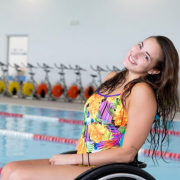Why the therapeutic team is part of the treatment
Scoliosis treatment, whether we are talking about exercises alone or also bracing, can be an uphill battle in which adherence to the therapy itself is always fundamental.
“A famous study conducted in the US and published in 2013 (Weinstein SL, Dolan LA, Wright JG, Dobbs MB. Effects of bracing in adolescents with idiopathic scoliosis. N Engl J Med. 2013 Oct.) confirmed beyond doubt the effectiveness of brace therapy in arresting the evolution of idiopathic scoliosis. And the patient’s adherence to the treatment was the factor that most influenced the result,” underlines physiotherapist Alessandra Negrini.
To ensure that a youngster manages to be collaborative in carrying out this demanding therapy, especially considering that it is often undertaken during early adolescence which is a notoriously tricky time, it is essential that all those interacting with the patient and with their family make sure they are always on the same page, giving clear and consistent messages.
With this in mind, it is easy to see why the therapeutic team, by encouraging patient compliance, plays such an important role in achieving the goals set.
Educating children and parents means explaining the nature of the disease, together with its possible course and potential consequences, setting and explaining realistic therapeutic objectives and rules to follow while performing physical (including home-based) exercises, and ensuring that there is cooperation with the physiotherapist and physician supervising the treatment. Specific physiotherapeutic exercises should be conducted by a trained and certified physiotherapist operating within a therapeutic team that includes a psychologist, orthotist, orthopaedist, and medical rehabilitation specialist.
The team that takes on the patient’s care needs to manage to lighten the burden of the treatment, and help the patient and their family to cope with the situation.
Within the multidisciplinary team, the physiotherapist is the patient’s point of reference, the one who motivates and, when necessary, re-motivates them. The physiotherapist is also the linchpin of the team itself.
“In view of this important role, the physiotherapist should always bear in mind three key rules that I always think of (in Italian) as the 3 As, explains physiotherapist Marta Tavernaro. The first “A” stands for addestrare (coaching), which reminds me of the need to explain to patients what is happening to them, what scoliosis actually means, and how we and they can prevent it from getting worse. The second “A” stands for approccio (approach), which in this case means being enthusiastic about what we are doing and conveying this to the patient; the third “A”, both in Italian and English, stands for “acquire”, in the sense of collecting the information you need to know whether the youngster in your care has been working effectively.”
During the rehabilitation process, the therapist may become aware of specific problems concerning the family and/or the young person that could jeopardise the treatment. The psychologist is the team member ideally placed to manage these difficulties.
In this regard, it is important to remember that this course of treatment is followed in what is already a difficult and delicate life stage, characterised by sudden changes that influence the young person’s developing personality and how they view their role in society: all of this can have important repercussions on the therapy.
“When we are working within a biopsychosocial model of care, we must of course also keep the psychological aspects in mind,” points out ISICO psychologist Dr Irene Ferrario. “In this case, adopting a person-centred approach means not only measuring the individual patient’s Cobb angle, but also taking into account their emotions and feelings at this particular time in their life. When the doctor or therapist senses that there is an underlying problem, they seek the intervention of the psychologist on the team, who, through individual counselling or psychotherapy, will probe and identify the factors responsible for the change.”
An ISICO study published a few years ago (Importance of team to increase compliance in adolescent spinal deformities brace treatment: a cross-sectional study of two different settings) highlighted the role of the therapeutic team. As pointed out by one of the authors, ISICO physiatrist Dr Andrea Zonta, “the concept of compliance has to be understood in a broad sense, and therefore as adherence not so much to the use of the brace or the prescribed programme of exercises, as to the entire therapeutic pathway, which can last years. After all, we will not obtain lasting results if we think we can intensify the exercises for a certain amount of time and then just abandon them”.
In our research, the population was split into two groups according to the setting in which the treatment was performed and the two groups were administered two questionnaires: the SRS-22 [3, 4], and another, specially developed, one (QT) with 25 multiple choice questions about adherence to treatment (sections: brace, exercises, team).In fact, since the population was chosen as having been treated by the same orthotist and physician, the only distinction between the two populations was in the physiotherapeutic and general team approach.
“If the therapeutic team is not working properly, and I refer particularly to the professionals involved, there is a great risk of pain and decreased QoL. The same is true with regard to compliance with bracing” concludes Dr Zonta. “Moreover, this study has shown that the SOSORT management criteria can be important for brace treatment. The results seem to confirm that the management of patients is sometimes neglected, probably because it is an aspect not understood or perceived by the people involved; nevertheless, effective patient management could (through increased compliance) be a main determinant of the final results and/or the patient’s immediate QoL”.












Leave a Reply
Want to join the discussion?Feel free to contribute!